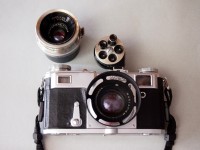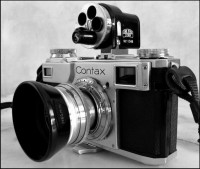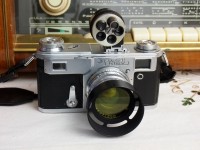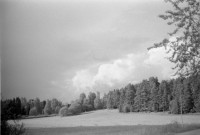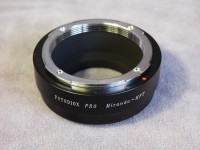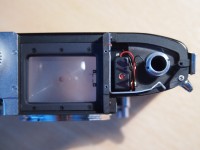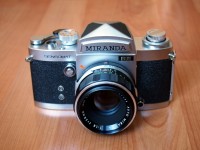A new Kiev 4A
A bit over a year ago I bought a ’80 Kiev 4A. It was quite a rough example, it worked… just and just, the shutter was noisy, they were slight grinding noises while advancing the film, and it had an annoying stubborn small light leak which I wasn’t able to trace and fix. All in all it wasn’t a pleasant camera to use – but it still clearly demonstrated the possibilities of the Contax/Kiev/Nikon S system; I was hooked, so I started looking for a better one. And found this: a Kiev 4A from year 1961 (serial number 6114681), sourced from Austria.
The difference between this and my old Kiev is like that of day and night: the ’61 version is much smoother, almost silent and much better finished; the covering is real leather instead of the ’80 model’s crappy plastic.
I have also been able to acquire some accessories for the Kiev: on the top left is a 35mm f/2.8 Jupiter-12 (serial number 611519), an Soviet-made copy of the legendary Zeiss Biogon lens. On the standard-issue 50mm f/2.0 Jupiter-8M (serial number 6121836) lens is fitted a cheap Chinese copy of a Leica lens hood (Walz-style). Sitting on the top of the camera is a KMZ-made turret viewfinder. This right-handed viewfinder is the “original” copy of the German-made Zeiss Ikon finder, and is correct for the Kiev. When the FED and KMZ factories started making their FED/Zorki Leica-copies, they noticed that the right-handed turret finder obstructed the use of speed selector on these, so they started making a left-handed model, too. The mirror-image model is much more plentiful today, consequently making the original model quite difficult to find (and more expensive). I found this one from Krasnodar, USSR.
For reference, here’s a picture of a 1936 Zeiss Contax II with a Zeiss turret finder.
Advice for potential buyers
If I had done my “homework” beforehand, so to say, I probably wouldn’t have bought the first Kiev. I’ve learned quite a lot about Contax/Kiev during the last year (some of the best information sources are listed in the “Resources”-section below), so, if you too are interested in buying a Kiev camera, I’m trying to share some of the knowledge here. The first two digits of the serial number tells the manufacturing year. The manufacturing years below are approximate, please see Resources for more accurate information concerning the various subtypes.
- Kiev 2 and 3, from 1947 on: These are almost a carbon copy of the original Zeiss Contax II and III, and at best, equal quality. For that reason they can also be quite expensive. If you are able to get one in reasonable condition and price, buy it!
- Kiev 4 and 4A, early version, from 1956 on: There were some mechanical changes to simplify manufacturing, but in general the build quality was very good. A good buy, like my ’61 shows.
- Kiev 4 and 4A, late version, from about 1974 to 1980: These late models can be easily identified by the plastic covering of the body and the self-timer lever. This is the point where the build quality dropped considerably; there’s even a rumour that in the early 80’s two months worth of cameras were dumped straight to the scrap heap. I do not say that you should avoid these models, just that you should be aware that you are literally playing Russian Roulette with these – early 70’s to early 80’s – Kievs. They can be very good if repaired and adjusted by a competent technician, but straight from the factory… No. Just no.
- Kiev 4M and 4AM, modernized version, from 1976 to 1987: These have somewhat modernized controls on the top. During the year 1982 the Kiev manufacturers shaped themselves up somewhat, so the later examples can be quite good (but not up to the original standard, unfortunately), but what was said about the late 4/4A applies to the pre-’82 4M/4AM versions, too.
– Soviet Cams: Kiev
– Kiev Rangefinders
– Kiev Survival Site
– Kiev 4A
– Matt’s Classic Cameras: Kiev 4A
– Contax II and III

